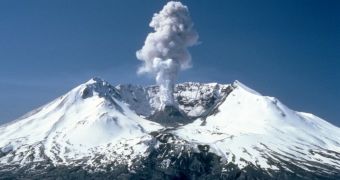This coming weekend, Mount St. Helens, an active volcano in the US, will be visited by about 75 geophysicists, including Rice University, University of Washington, and University of Texas at El Paso researchers.
The group of scientists will not visit Mount St. Helens for pleasure. On the contrary, their plans to spend a few days exploring this volcano's slopes boil down to work seasoned with – what else – some more work.
Thus, Phys Org tells us that the 75 geophysicists hope to successfully place over 3,500 active seismological sensors and 23 seismic charges, i.e. devices producing shock waves, around the active volcano.
The sensors and the charges will serve to monitor activity patterns inside Mount St. Helens. Information obtained in this manner should help the geophysicists make head and tail of the volcano's anatomy.
Specifically, the scientists explain that what they have in mind is carrying out the equivalent of an ultrasound and a CAT scan. This full body check should make it possible to piece together a detailed picture of Mount St. Helen's internal plumbing.
The 23 seismic charges that will be used during this investigation will be deployed in holes whose depth will reach about 80 feet (approximately 24 meters). Most of the detonations should occur on the evening of July 22 – 23. Others will follow on July 30.
The shock waves produced by the seismic charges will be about as intense as a magnitude 2 earthquake. Still, the scientists reassure that people in the area will not in any way be affected by them, and that Mount St. Helens' stability will not be disturbed either.
“Our shots will provide enough seismic energy to develop a clear picture of the mountain's inner workings, but in most cases not enough to be felt and certainly no more than low-level seismic activity that occurs in the area on a weekly basis,” explained scientist Alan Levander.
The over 3,500 seismological sensors that volunteers will help set in place around the volcano will collect information concerning the movement of the shock waves produced by the seismic charges through rocks and molten material that make up the volcano.
Together with data revealing local fluctuations in the Earth's magnetic field, which is known to be influenced by the makeup of rocks and fluids it encounters, this data will be used to reveal Mount St. Helen's plumbing, the geophysicists explain.
Commenting on the need to learn more about this volcano's anatomy, Alan Levander said, “Mount St. Helens and other volcanoes in the Cascade Range threaten urban centers from Vancouver to Portland, and we'd like to better understand their inner workings in order to better predict when they may erupt and how severe those eruptions are likely to be.”

 14 DAY TRIAL //
14 DAY TRIAL //